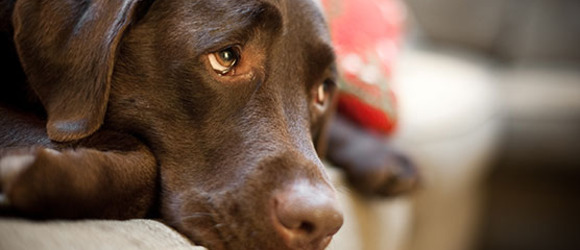Coming home to chewed up curtains, dog pee in the carpet, scratch marks on the doors, and neighbors complaining about the noise is a frustrating but common issue dog parents face. All of these things may be a sign of boredom, lack of exercise, or training. Or it may be a sign that your dog is in distress. Dogs with separation anxiety experience panic when you leave the house. Here are six signs that your dog may have this condition:
1. He Follows You Everywhere
The first sign occurs before you’ve even thought about leaving the house. Your dog follows you like a shadow and would probably surgically sew himself to you if he knew how to.
2. He Gets Anxious When You’re About to Leave
Dogs are smart and quickly pick up on your routines and gestures. If he sees you preparing to leave the house, he may start drooling or show other signs of distress such as barking the moment you’re out the door.
3. The Neighbors Complain About the Noise
This is usually the most obvious and embarrassing sign for most people. You hear reports that your dog barked, howled and cried for hours while you were gone. Applying an anti-bark collar in this situation is not the solution and will not relieve the distress your pup is going through.
4. He’s Going To the Toilet On Your Floor
Defecating inside the house may be a sign of stress. If he also does it when you’re home, the issue may be medical or related to incomplete training, not separation anxiety.
5. Your House is Destroyed When You Get Home
Despite popular belief, house destruction is not your dog’s way of punishing you for leaving. Chewing is a behavior that helps calm your canine down when he’s stressed. Your ripped up shoes may be his coping mechanism. Chewed up door frames, destroyed carpet, and scratched doors may be signs of attempted escapes.
6. Your Dog Tries to Escape the House or Yard
It’s not that he’s trying to run away. If your dog does indeed have separation anxiety, he may try to find you by escaping from your home.
If your dog has mild separation anxiety, this can be alleviated by associating alone time with good things like his favourite treats. A Kong toy full of frozen mince or his food for the day will keep him busy and happy for a prolonged time. You leaving can become exciting if it means dinner time for him.
For more serious cases, it’s important to get to the root cause of the issue. This involves slowly desensitizing him to you being away from home, starting with short periods of time then eventually making them longer and more frequent. Serious cases can be tricky to fix and getting help from an animal behaviorist would be very beneficial in this situation.
The following post is by DANICA T



